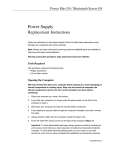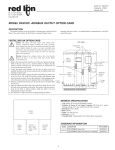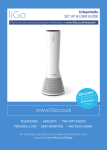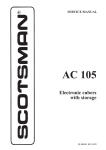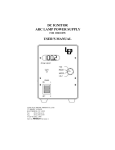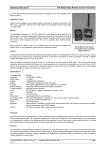Download ATD Tools ATD-10835 User's Manual
Transcript
ATD-10836 Cordless Screwdriver 3.6V Lithium ion 3 2 1 8. ON/OFF Switch 9. LED Light On/Off Button 10.LED Light 11. Charger Plug 12. 120V Charger Adaptor Motor: Input: No load speed: 3.6 V 120V ~ 60Hz 200/min Output: Battery: Gearbox: 6V DC 300mA 3.6V 1300mAh Single Speed General Power Tools Safety Warnings WARNING! Read all safety warnings and all instructions. Failure to follow the warnings and instructions may result in electric shock, fire and/or serious injury. Save all warnings and instructions for future reference. The term “power tool” in all of the warnings refers to your mains-operated (corded) power tool or battery-operated (cordless) power tool. 1) Work area safety a) Keep work area clean and well lit. Cluttered or dark areas invite accidents. b) Do not operate power tools in explosive atmospheres, such as in the presence of flammable liquids, gases or dust. Power tools create sparks which may ignite the dust or fumes. c) Keep children and bystanders away while operating a power tool. Distractions can cause you to lose control. 2) Electrical safety a) Power tool plugs must match the outlet. Never modify the plug in any way. Do not use any adapter plugs with earthed (grounded) power tools. Unmodified plugs and matching outlets will reduce risk of electric shock. b) Avoid body contact with earthed or grounded surfaces, such as pipes, radiators, ranges and refrigerators. There is an increased risk of electric shock if your body is earthed or grounded. c) Do not expose power tools to rain or wet conditions. Water entering a power tool will increase the risk of electric shock. d) Do not abuse the cord. Never use the cord for carrying, pulling or unplugging the power tool. Keep cord away from heat, oil, sharp edges or moving parts. Damaged or entangled cords increase the risk of electric shock. e) When operating a power tool outdoors, use an extension cord suitable for outdoor use. Use of a cord suitable for outdoor use reduces the risk of electric shock. f) If operating a power tool in a damp location is unavoidable, use a residual current device (RCD) protected supply. Use of an RCD reduces the risk of electric shock. 3) Personal safety a) Stay alert, watch what you are doing and use common sense when operating a power tool. Do not use a power tool while you are tired or under the influence of drugs, alcohol or medication. A moment of inattention while operating power tools may result in serious personal injury. b) Use personal protective equipment. Always wear eye protection.Protective equipment such as dust mask, non-skid safety shoes, hard hat, or hearing protection used for appropriate conditions will reduce personal injuries. c) Prevent unintentional starting. Ensure the switch is in the off-position before connecting to power source and/or battery pack, picking up or carrying the tool. Carrying power tools with your finger on the switch or energising power tools that have the switch on invites accidents. d) Remove any adjusting key or wrench before turning the power tool on. A wrench or a key left attached to a rotating part of the power tool may result in personal injury. e) Do not overreach. Keep proper footing and balance at all times. This enables better control of the power tool in unexpected situations. f) Dress properly. Do not wear loose clothing or jewellery. Keep your hair, clothing and gloves away from moving parts. Loose clothes, jewellery or long hair can be caught in moving parts. g) If devices are provided for the connection of dust extraction and collection facilities, ensure these are connected and properly used. Use of dust collection can reduce dust-related hazards. 9 8 7 6 CAUTION: Read this operation manual before using this tool. Specifications 5 12 10 1. 6.35mm (1/4”) Quick Connect Chuck 2. Torque Collar 3. Battery Charge Indicator 4. Rear Rotating handle lock button 5. Forward/Reverse Slide Lever 6.Charge Indication LED 7. Charging Socket 4 11 4) Power tool use and care a) Do not force the power tool. Use the correct power tool for your application. The correct power tool will do the job better and safer at the rate for which it was designed. b) Do not use the power tool if the switch does not turn it on and off. Any power tool that cannot be controlled with the switch is dangerous and must be repaired. c) Disconnect the plug from the power source and/or the battery pack from the power tool before making any adjustments, changing accessories, or storing power tools. Such preventive safety measures reduce the risk of starting the power tool accidentally. d) Store idle power tools out of the reach of children and do not allow persons unfamiliar with the power tool or these instructions to operate the power tool. Power tools are dangerous in the hands of untrained users. e) Maintain power tools. Check for misalignment or binding of moving parts, breakage of parts and any other condition that may affect the power tool’s operation. If damaged, have the power tool repaired before use. Many accidents are caused by poorly maintained power tools. f) Keep cutting tools sharp and clean. Properly maintained cutting tools with sharp cutting edges are less likely to bind and are easier to control. g) Use the power tool, accessories and tool bits etc. in accordance with these instructions, taking into account the working conditions and the work to be performed. Use of the power tool for operations different from those intended could result in a hazardous situation. 5) Battery tool use and care a) Recharge only with the charger specified by the manufacturer. A charger that is suitable for one type of battery pack may create a risk of fire when used with another battery pack. b) Use power tools only with specifically designated battery packs. Use of any other battery packs may create a risk of injury and fire. c) When battery pack is not in use, keep it away from other metal objects, like paper clips, coins, keys, nails, screws or other small metal objects, that can make a connection from one terminal to another. Shorting the battery terminals together may cause burns or a fire. d) Under abusive conditions, liquid may be ejected from the battery; avoid contact. If contact accidentally occurs, flush with water. If liquid contacts eyes, additionally seek medical help. Liquid ejected from the battery may cause irritation or burns. 6) Service a) Have your power tool serviced by a qualified repair person using only identical replacement parts. This will ensure that the safety of the power tool is maintained. b) If the supply cord is damaged, it must be replaced by the manufacturer, its service agent or similarly qualified persons in order to avoid a hazard. Additional Safety Instructions For Chargers And Batteries Danger! If the battery pack case is cracked or damaged, do not insert into charger. There is a danger of electric shock or electrocution. Warning! Don’t allow any liquid to get inside charger. Electric shock may result. To facilitate cooling of the battery pack after use, avoid placing the charger or battery pack in a warm environment such as in a metal shed, or an un-insulated trailer. • Before using the charger, read all instructions and cautionary markings on charger, battery pack and product using the battery pack. • Do not place any object on top of the charger or place the charger on a soft surface that may result in excessive internal heat. Place the charger in a position away from any heat source. • To reduce risk of damage to the electric plug and cord, pull by the plug rather than the cord when disconnecting the charger. • Make sure cord is located so that it will not be stepped on, tripped over, or otherwise subjected to damage or stress. Additional Safety Instructions For Chargers And Batteries (cont.) • An extension cord should not be used unless absolutely necessary. Use of an improper extension cord could result in the risk of fire, electric shock or electrocution. • Do not operate charger if it has received a sharp blow, been dropped or otherwise damaged in any way. Have it checked by an electrician or power tool repairer. • Do not disassemble charger. Take it to an electrician or power tool repairer when service or repair is required. Incorrect reassembling may result in a risk of electric shock, electrocution or fire. • To reduce risk of electric shock, unplug charger from the outlet before attempting any cleaning. Removing the battery pack will not reduce this risk. • Never attempt to connect 2 chargers together. • DO NOT store or use the tool and battery pack in locations where the temperature may reach or exceed 40ºC (such as outside sheds or metal buildings in summer). • The charger is designed to operate on standard household electrical power (120 Volts). Do not attempt to use it on any other voltage! The battery pack is not fully charged out of the carton. First read the safety instructions and then follow the charging notes and procedures. • The longest life and best performance can be obtained if the battery pack is charged when the air temperature is between 18 - 24ºC. Do not charge the battery pack in an air temperature below 10o C or above 40ºC. This is important and will prevent damage to the battery pack. • Do not incinerate the battery pack even if it is seriously damaged or is completely worn out. The battery can explode in a fire. • Never attempt to open the battery pack for any reason. If the plastic housing of the battery pack breaks or cracks, immediately discontinue use and do not recharge. Forward / Reverse Lever To select the forward or reverse on your screwdriver simply push the forward/ reverse slide lever (5) to the left side for reverse (R) or the right side for forward (F). To lock the screwdriver simply ensure that the forward/reverse lever (5) is placed in between forward or reverse position. Torque Settings When using your screwdriver for various driving applications, it becomes necessary to increase and decrease the power and torque in order to prevent the possibility of damaging screw heads, threads, work piece, etc. In general, power and torque should correspond to the size of the screw and the material type that the screw is being driven into. To Adjust Torque • Locate the arrow on the front of torque collar (2). • Identify the drill bit icon or non torque setting and 6 torque settings on the front of the drill. • Rotate the torque collar (2) to the desired setting aligning the number on the front of the screwdriver with the arrow torque collar (2). • To increase or decrease torque, rotate torque collar (2). The lower the number, the lower the torque or twisting action the screwdriver will produce. The higher the number, the higher the torque or twisting action the screwdriver will produce. Always check that the correct torque setting is selected by practicing on scrap material prior to carrying out a job. Pre Drilling your Material It is recommended to pre drill holes in the material you are about to screw into. Pre drilling holes will assist the screwdriver when driving screws and enable your tool to operate efficiently. This appliance is not intended for use by persons (including children) with reduced physical, sensory or mental capabilities, or lack of experience and knowledge, unless they have been given supervision or instruction concerning use of the appliance by a person responsible for their safety. Operation Of The Screwdriver Only use driver/drill bits which can be securely fastened in the quick connect chuck (1) and for which the bits have been designed. Before using the screwdriver check whether the screw-bit is inserted correctly. Avoid over-tightening screws, otherwise the screw head may be damaged or stripping of the threads may occur. Operation Screw Insertion Set the direction of rotation of the screwdriver to the clockwise/forward direction using the forward/reverse lever (5). Insert the required driver bit into the head of the screw. Hold the driver bit in line with the head of the screw, otherwise the screw or the screw head may be damaged. Always keep constant pressure while driving in the screw to avoid damage to the driver bit or screw head. Depress the On/Off switch (8) to start driving the screw into your workpiece. Always hold the screwdriver firmly and when the screw is completely screwed in, release the On/Off switch (8), otherwise the screw or the screw head may be damaged. If the On/Off switch (8) is not released immediately the high torque could also damage the driver bit or the screwdriver. Charging the Battery This tool has been shipped in a low charge condition and should be fully charged prior to use. Plug the 120V charger adaptor (12) into an appropriate AC power outlet and switch on. Connect the charger plug (11) of the AC adaptor into the charging socket (7) of the screwdriver. The red charge indication LED (6) will illuminate. The batteries will take 3-5 hours to charge. This may vary up to 7 hours due to the level of charge left in the batteries and also the ambient temperature. NOTE: The charge indicator LED (6) will always be illuminated when the charger is plugged in and turned on! Initial Charge Charge your battery for 5-7 hours then use it until it runs down and only slowly operates. Recharge for 5-7 hours again. Once again run your tool until only a small amount of charge remains. Repeat the above cycle about 4 or 5 times, this should set the battery “memory”, then charge as earlier stated. Caution: This charger does not automatically turn off when the battery is fully charged. Please take care not to leave the tool on the charger turned on for excessive periods of time. Switch off the charger at mains when charging is complete. NOTE: The charge indicator LED (6) will be illuminated when the charger is plugged in charging the screwdriver. The charge indicator LED (6) will turn off when the screwdriver is fully charged. Inserting Driver Bits Important! Always unplug the charger and make sure the forward/reverse lever (5) is in the lock position. Refer to Forward / Reverse Lever in the coming instructions. The screwdriver has a quick connect chuck (1) feature, simply slide the collar of the quick connect chuck (1) back towards the torque collar (2) to either insert or extract the driver bits you are using. Release the collar once you have inserted the driver bit to lock in your bit. Replacement Driver Bits can be purchased at any tool store. ,, Always ensure that you only use single ended 2 . For driver bits shorter than 50mm, it must be used with bits holder which is also included in this kit. Otherwise, shorter driver bits may become stuck or hard to remove from the screwdriver. On/Off Switch Depress the On/Off trigger (8) to start the screwdriver and keep holding it for continuous operation. To stop the screwdriver, release the On/Off trigger (8). Note: This screwdriver does not have variable speed! Screw Removal Set the direction of rotation of the screwdriver to the anticlockwise/reverse direction using the forward/reverse lever (5). Insert the required driver bit into the head of the screw. Hold the driver bit in line with the head of the screw, otherwise the screw or the screw head may be damaged. Always keep constant pressure while driving or removing the screw to avoid damage to the driver bit or screw head. Depress the On/Off switch (8) to start removing the screw from your workpiece. Always hold the screwdriver firmly and when the screw is completely removed, release the On/Off switch (8). Rotating Rear Handle This screwdriver has two different handle configurations to assist with your job requirements. Inline will assist you in hard to reach areas where additional reach is required. Bent or “L” shape will provide you with additional grip for those jobs where more torque is required. To return the handle to the original position press the rotating handle lock button (4) and rotate the handle clockwise till the handle locks into position. Operation (cont.) Battery Charge Indicator The screwdriver is equipped with a battery charge indicator (3) to assist you to determine how charged your screwdriver may currently be. To check how much charge your screwdriver may have simply press the button below the battery charge indicator (3) and the LED lights will illuminate. A red Led informs you that the screwdriver requires charging, an orange Led indicates that the screwdriver is low in charge andquires charging. A green LED indicates that the screwdriver is fully charged and ready for use. LED Light The screwdriver has a built in LED light (10) to illuminate dark areas. Simply press the LED light On/Off button (9) on and off as required. Turn off the LED light when not needed to save battery life by pressing the LED light On/Off button (9) again. This will turn off the LED light (10). Maintenance • Keep the ventilation vents of the tool clean at all times, if possible, prevent foreign matter from entering the vents. • After each use, blow air through the tool housing to ensure it is free from all dust particles which may build up. Build up of dust particles may cause the tool to overheat and fail. • If the enclosure of the tool requires cleaning do not use solvents but a moist soft cloth only. Never let any liquid get inside the tool; never immerse any part of the tool into a liquid. Description of Symbols V Volts ~ Alternating current Milliamperes mA A Amperes dc Direct current Hz Herts W Watts no No load speed Revolutions or reciprocation per minute /min Warning Double insulated Note: ATD Tool will not be responsible for any damage or injuries caused by the repair of the tool by an unauthorised person or by mishandling of the tool. Isolation transformer Indoor use only Caring For The Environment Power tools that are no longer usable should not be disposed of with household waste but in an environmentally friendly way. Please recycle where facilities exist. Check with your local council authority for recycling advice. Recycling packaging reduces the need for landfill and raw materials. Reuse of recycled material decreases pollution in the environment. Please recycle packaging where facilities exist. Check with your local council authority for recycling advice. Polarity Contents 1 x Cordless Screwdriver 1 x Charger ,, 1 x 2 1/4 Bits Holder ,, 28 x 1 CRV Bits ,, 6 x 2 CRV Bits 1 x Instruction manual Parts List No. 1 2 3 4 5 6 7 8 9 10 11 12 13 14 15 16 17 18 19 20 21 22 23 24 25 26 27 28 29 30 31 32 33 34 35 36 37 Part no. Description PRT10836-01 PRT10836-02 PRT10836-03 PRT10836-04 PRT10836-05 PRT10836-06 PRT10836-07 PRT10836-08 PRT10836-09 PRT10836-10 PRT10836-11 PRT10836-12 PRT10836-13 PRT10836-14 PRT10836-15 PRT10836-16 PRT10836-17 PRT10836-18 PRT10836-19 PRT10836-20 PRT10836-21 PRT10836-22 PRT10836-23 PRT10836-24 PRT10836-25 PRT10836-26 PRT10836-27 PRT10836-28 PRT10836-29 PRT10836-30 PRT10836-31 PRT10836-32 PRT10836-33 PRT10836-34 PRT10836-35 PRT10836-36 PRT10836-37 CORLESS SCREWDRIVER REPLACEMENT CHARGER #3 Slotted Screwdriver Bit-1" #4 Slotted Screwdriver Bit-1" #5 Slotted Screwdriver Bit-1" #6 Slotted Screwdriver Bit-1" #7 Slotted Screwdriver Bit-1" #0 Phillips Screwdriver Bit-1" #1 Phillips Screwdriver Bit-1" #2 Phillips Screwdriver Bit-1" #3 Phillips Screwdriver Bit-1" #0 Pozi Screwdriver Bit-1" #1 Pozi Screwdriver Bit-1" #2 Pozi Screwdriver Bit-1" #3 Pozi Screwdriver Bit-1" 2mm Hex Bit 2.5mm Hex Bit 3mm Hex Bit 3.5mm Hex Bit 4mm Hex Bit 5mm Hex Bit 6mm Hex Bit T10 Torx Bit T15 Torx Bit T20 Torx Bit T25 Torx Bit T27 Torx Bit T30 Torx Bit T40 Torx Bit T45 Torx Bit #00 Phillips Screwdriver Bit 2" #0 Phillips Screwdriver Bit-2" #1 Phillips Screwdriver Bit-2" #2 Phillips Screwdriver Bit-2" #4 Slotted Screwdriver Bit-2" #6 Slotted Scewdriver Bit-2" 2 1/4" Bit Holder Qty 1 1 1 1 1 1 1 1 1 1 1 1 1 1 1 1 1 1 1 1 1 1 1 1 1 1 1 1 1 1 1 1 1 1 1 1 1




